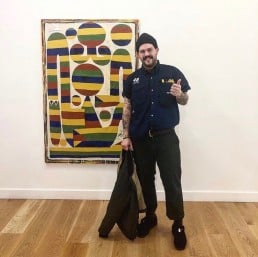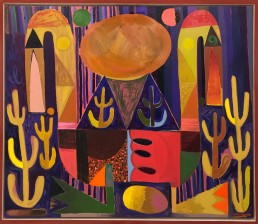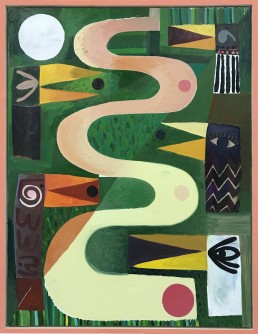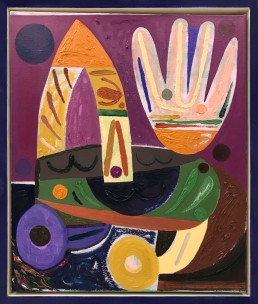Interviews
Interview and Studio Visit: Austin Eddy
by Artland Editors


On a recent visit to New York, Artland sat down with Austin Eddy in his studio to ask him a few questions about his paintings and working practice. This weekend his works can be seen at the Dallas Art Fair in the booth of renowned talent spotters HALF Gallery, of NYC.
Hi Austin, Thanks for having us over. I want to start by identifying a common ground that seems to exist in your paintings. The compositions all have a very flat perspectival space, with close together elements, rendered in bold colours. What rules, if any, do you set for yourself to create this kind of stylistic ‘order’ we have come to expect from your paintings?
I try not to have too many rules in place when working. I kind of want to be a passenger to the painting. A lot of the time I will think about limiting the colors to a specific time place or mood. Relying more on the experience to drive the formal relationships.
I think the desire to push the forms to the edge of being recognizable creates a similar understanding from painting to painting. But I guess they all come from me so that helps provide a continuity of order or logic…
The elements in your paintings are clearly sometimes a little like pictograms for things, sometimes less so. How do you determine this balance between between abstraction and figuration, which of course has become a key tension for lots of painters in the modern and post-modern periods?
Maybe it’s being an American, or maybe it’s everyone’s dream, I don’t know. But when I was in high school and college I wanted to be an abstract artist. It was the idea of being like a cowboy, and being a cowboy was like being free. That really appealed to me, but not who I am. I like seeing and knowing, seeing and knowing from across the street on a foggy evening. Just enough to know something, but reliant on the imagination for more.
I am too tied to the real world and a lot of the work is found in fighting against my self trying to hold on. I think the images live between their most basic structures that make them up, and the nuances of personality. You can paint a room, and it can be dull, but you make it red, and omit information and it suddenly becomes more interesting.
It’s the not knowing that makes life exciting!

Austin Eddy, Desert Birds, Marfa Lights, August. 2018. Oil, colored pencil, Flashe, paper on canvas in artist frame 38×42”
Your paintings have a kind of folksy appeal if you forgive the term, whilst also referencing some key elements of what I would describe as early twentieth century modernism. Are there any early art experiences that you feel have shaped this direction, and which artists have particularly inspired you?
I have been working at The New York Historical Society off and on for a number of years now, and a few years back they did a really lovely show of Elie Nadelman’s collection of objects and early American Folk art. I had always had an interest in folk art particularly the Gees Bend Quilters, and the more traditional American image quilts. I was drawn to the flatness and the bending of perspective and space. The Horizon line wraps and can be a vertical plane, the logic of the natural world applies but from all sides. It seems more human than just painting the picture from one singular view point. In seeing the show of his collection, I came across various collections of antique clothes pins, milliners heads, cookie molds all seemingly made by untrained craftsmen, and I found them quite elegant. Seeing these things asked me to look deeper. And in looking I uncovered so many inspiring objects and approaches to simplifying forms. Oddities.
But more traditionally I have been quite drawn to Jean Arp, Alexander Calder, Constantie Brancusi, and at the end of the day unavoidably interested also in Matisse, Picasso, Leger, and of course Chagall.

Austin Eddy, The River In The Marsh Populated With Wings, Portland Oregon, Summer 2018, 2018, Oil, colored pencil, Flashe, paper on canvas in artist frame, 44×34 in.
Do you feel that living and working in NYC and being part of this huge art ecosystem has changed your practice in any significant ways?
Living in NYC is a really special thing. It can be quite ugly, but there is a kind of calmness in ugliness. An oasis in the perpetual aspiration for beauty.
It has been a lot of work living here, and most of the time it has been really difficult. But at the end of the day it’s been a rewarding and lovely challenge. The feeling of a common struggle to fight against the overwhelming aspects of the city helps build a really strong bond between people, there is an sense of community among strangers. I also think the amount of access to so much visual input really forces one to grow in ways you wouldn’t expect or even notice. Over all, I think the support of my peers and wild amount of access to resources has allowed my practice to move and shift along in various and unexpected ways.

Austin Eddy, A Red Pagoda, Red Spring, Red And Green Birds With Pink Eggs, 2018, Oil, colored pencil, Flashe, paper on canvas in artist frame, 50×32 in.
I’d like to ask a bit about your process of painting. Do you make preparatory drawings, and what is your methodology for working up the painting to completion? Tell us a bit about the anatomy of making an Austin Eddy painting!
The work has been in a state of flux for the past few years.
Previously there was very little planning in the paintings and drawings, just a very direct approach to making. No planning, just moving. And in doing that, the work took various approaches. At first it was collage and drawing based, and then moved into strictly cut forms to construct the images – it seemed like anything to avoid painting. After a few years of avoiding the elephant in the room I started to use a paintbrush again and was creating very flat shape paintings which relied heavily on the language of collage. It has not been until recently I started doing oil paintings proper. And I am still working through figuring that all out. A lot of these newer works manifest themselves in various forms. Some start as sketches then get made again as paintings on paper, and then again as larger paintings. And sometimes the same painting gets made twice, but different. I try to still keep the paintings fresh and not over worked, as much “wet into wet” as possible. Moving forward not backwards.
But there is always room to go back and try again.
You are starting to get some nice gallery opportunities and you will also be showing this weekend at the Dallas Art Fair. What do you think of Fairs as forums for artists to show their work?
I think the fairs are not really for the artists. They are more for everyone else.
It’s nice to show at a fair, but its only a brief interjection of thought.
To get a real understanding of someones work or practice its important to see a show. A fair is not too dissimilar to a mix tape, a sampling to spark your interest and possibly lead one to look deeper into something you find.

Austin Eddy, The Sixth Geese Laying, Late Night, 2018, Oil, colored pencil, Flashe, paper on canvas in artist frame, 26×22 in.